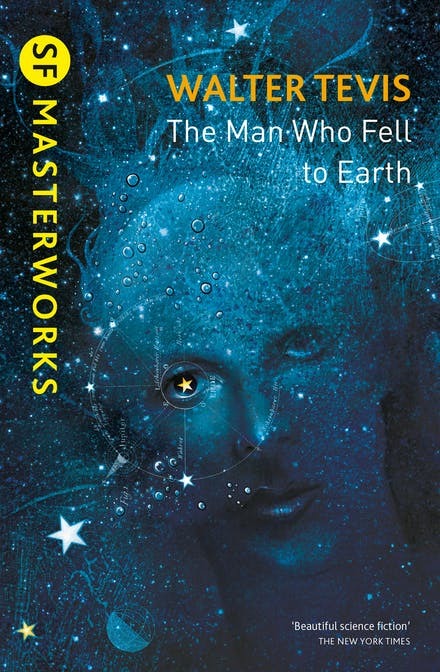search
date/time
 | Lancashire Times Weekend Edition |

James Goodall
Features Writer
7:03 AM 23rd July 2020
arts
What Is Alien? Bridging The Abyss In The Man Who Fell To Earth And Under The Skin

The 1976 ecranisation, with David Bowie impeccably cast in the titular role, is less explanatory in terms of its narrative and more of a hallucinatory experience. Key themes are hinted at subliminally, and you could easily be at a loss, unless familiar with the source material, which is by far and away the weightier tract. The extraterrestrial visitor in this instance appears human, or at least is adequately disguised to this effect, passing under the pseudonym Thomas Jerome Newton. It is immediately apparent that he is not here to wreak havoc against us. Earth’s environment, if anything, is a source of discomfort to him: he exists in a state of permanent lassitude on account of the gravity differentials, which we later see shatter his leg joints in a lift; he converses in a sotto voce tone, as though his every word is weariness; he relies upon heavily air-conditioned rooms with dimmed lighting for the sake of his more sensitive biochemistry. His primary motive, here on Earth, is not one of conquest; he is here because his home planet of Anthea is dying, starved of its natural resources. His mission is one of mercy: to create a safe haven for the last of his people. In short, he is a benign visitor. Not evil.

Walter Tevis
Interestingly, Newton finds that the closer he comes to humanity, the more he is corrupted by it, growing indolent and quaffing vodka all day with his live-in P.A. Furthermore, we see him undergo a crisis of identity in a fantastic Freudian mirror moment whereby, after removing his human disguise, he ceases to recognise his true reflection – “His own body stared back at him; but he could not recognise it as his own. It was alien and frightening”. In a curious perversion of Stockholm Syndrome, he joins the ranks of his persecutors in othering himself!
But there is hope to be had. Newton concludes that there is common ground between himself and Man, and his closest human colleague, Bryce, concedes the same: “[He] seemed … ‘more human’, now that he had made it clear he was, in fact, no such thing”. Both, therefore, are in agreement that neither should jump to discriminate against the other.
...

In the 2013 film adaptation, we see Scarlett Johansson immersing her hitchers in a nacreous black slime, which she is impervious to and can walk across. It’s unclear what is taking place here, but the novel eventually discloses that her human victims are in fact being processed at a farmstead for alien consumption. So when Isserley is scouting for “hunks on two legs”, she is in fact referring to “hunks of meat”! In many ways, Faber’s novel can thus be read as an indictment of factory farming methods. It is blackly macabre in its descriptions, and the issue is brought home to us all the more, perhaps hypocritically so, because human beings in this instance are the cattle. Not exactly bedtime reading then! Certainly, after this reading experience, I was all set for a week of veganism.
But, despite her predatory portrayal, Isserley is not an evil alien presence on Earth, and we can sympathise with her plight here. Like Newton she has fled a rapidly-dying home planet where basic necessities for life, such as clean air and water, are in short supply. Her people have never seen sky, let alone oceans. Her motive, therefore, is not one of conquest but self-preservation. It is then we appreciate the full implications of the decision she has made, for she has paid a terrible price for a more salubrious life on Earth. She has been surgically modified to appear human – de-limbed from a quadruped to a biped, her natural fur pelt shaven, and oversized false breasts grafted onto her torso. Consequently, she spends her days in near-permanent discomfort, suffering from post-op complications.

Michael Faber
As in Tevis’ work, man is depicted as the greater purveyor of evil. Nearly every hitcher who enters Isserley’s car makes her feel uncomfortable, and one hitcher even violently attacks her. In this pivotal scene the roles of predator and prey are pointedly reversed, and she is only able to escape by dint of her own ingenuity and resourcefulness. Also, the human hitchers are granted a first-person narrative voice, whereas Isserley (the other) is only granted a third-person point of view – denied the right, effectively, to speak for herself. Ultimately, though our initial perspective of Isserley may have been that of a hostile entity, once we appreciate the myriad hardships she has been made to endure, we can feel compassion for her.
...
To hark back to Nietzsche’s earlier apophthegm, it seems there will always be othering, no matter how far we come: “The power of moral prejudices has penetrated deeply into the most intellectual world, the world apparently most indifferent and unprejudiced”. But, as the experiences of Newton and Isserley demonstrate, before we rush to other that which is outside our own frame of reference, perhaps we should first do some soul-searching ourselves! Imagine what a different movie it would have been if Arnie and the predator, instead of exchanging rounds of gunfire, had sat down to discuss their feelings! Or, if Forbidden Planet’s Dr Morbius had been more introspective, he’d have understood sooner that the rampaging monster of Altair-4 was not in fact alien but his own “id” made manifest – that the abyss had stared back!